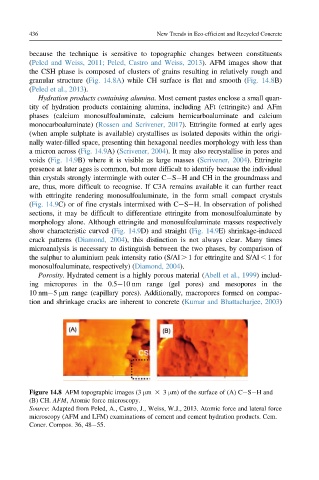Page 486 - New Trends in Eco efficient and Recycled Concrete
P. 486
436 New Trends in Eco-efficient and Recycled Concrete
because the technique is sensitive to topographic changes between constituents
(Peled and Weiss, 2011; Peled, Castro and Weiss, 2013). AFM images show that
the CSH phase is composed of clusters of grains resulting in relatively rough and
granular structure (Fig. 14.8A) while CH surface is flat and smooth (Fig. 14.8B)
(Peled et al., 2013).
Hydration products containing alumina. Most cement pastes enclose a small quan-
tity of hydration products containing alumina, including AFt (ettringite) and AFm
phases (calcium monosulfoaluminate, calcium hemicarboaluminate and calcium
monocarboaluminate) (Rossen and Scrivener, 2017). Ettringite formed at early ages
(when ample sulphate is available) crystallises as isolated deposits within the origi-
nally water-filled space, presenting thin hexagonal needles morphology with less than
a micron across (Fig. 14.9A) (Scrivener, 2004). It may also recrystallise in pores and
voids (Fig. 14.9B) where it is visible as large masses (Scrivener, 2004). Ettringite
presence at later ages is common, but more difficult to identify because the individual
thin crystals strongly intermingle with outer C S H and CH in the groundmass and
are, thus, more difficult to recognise. If C3A remains available it can further react
with ettringite rendering monosulfoaluminate, in the form small compact crystals
(Fig. 14.9C) or of fine crystals intermixed with C S H. In observation of polished
sections, it may be difficult to differentiate ettringite from monosulfoaluminate by
morphology alone. Although ettringite and monosulfoaluminate masses respectively
show characteristic curved (Fig. 14.9D) and straight (Fig. 14.9E) shrinkage-induced
crack patterns (Diamond, 2004), this distinction is not always clear. Many times
microanalysis is necessary to distinguish between the two phases, by comparison of
the sulphur to aluminium peak intensity ratio (S/Al . 1 for ettringite and S/Al , 1for
monosulfoaluminate, respectively) (Diamond, 2004).
Porosity. Hydrated cement is a highly porous material (Abell et al., 1999)includ-
ing micropores in the 0.5 10 nm range (gel pores) and mesopores in the
10 nm 5 μm range (capillary pores). Additionally, macropores formed on compac-
tion and shrinkage cracks are inherent to concrete (Kumar and Bhattacharjee, 2003)
Figure 14.8 AFM topographic images (3 μm 3 3 μm) of the surface of (A) C S H and
(B) CH. AFM, Atomic force microscopy.
Source: Adapted from Peled, A., Castro, J., Weiss, W.J., 2013. Atomic force and lateral force
microscopy (AFM and LFM) examinations of cement and cement hydration products. Cem.
Concr. Compos. 36, 48 55.

